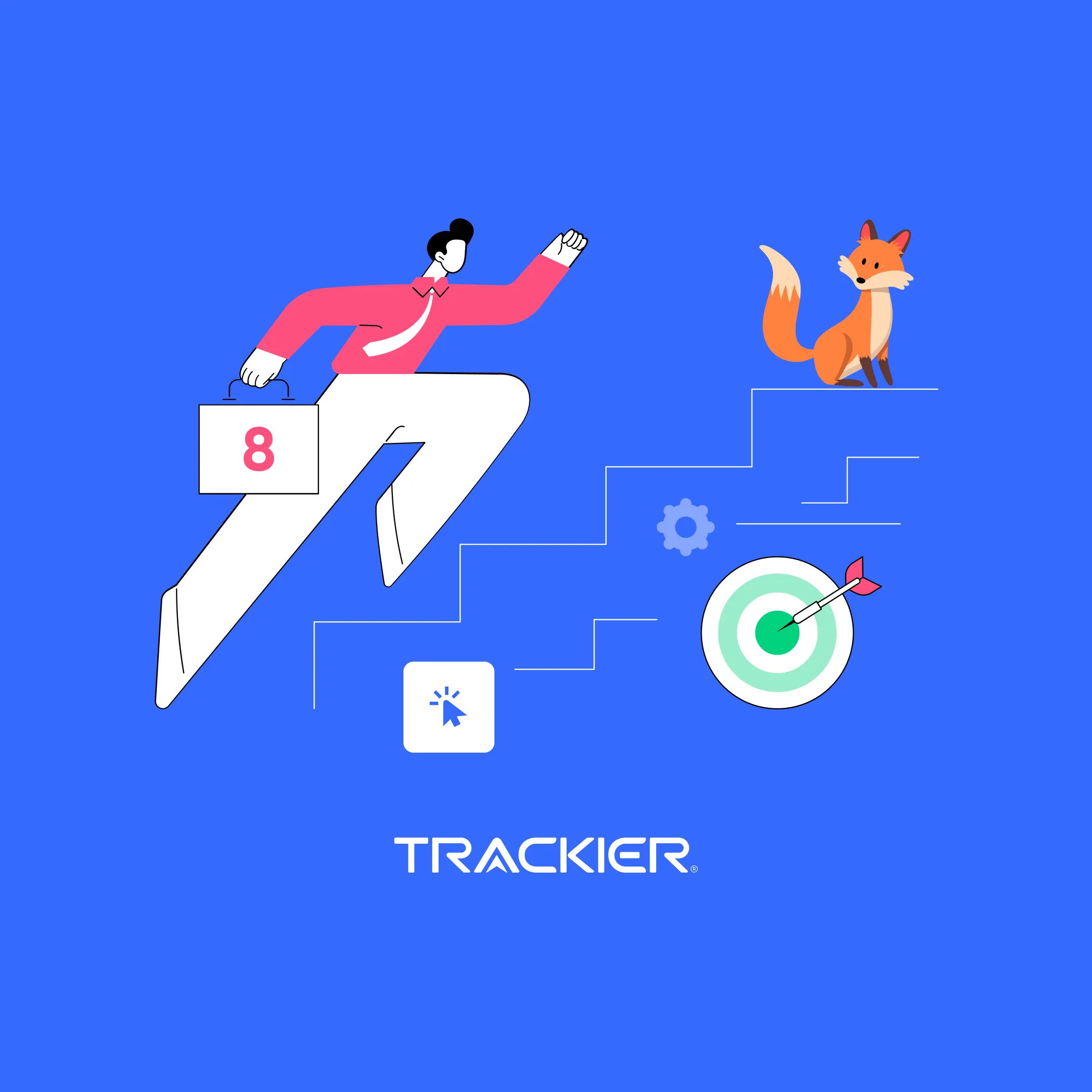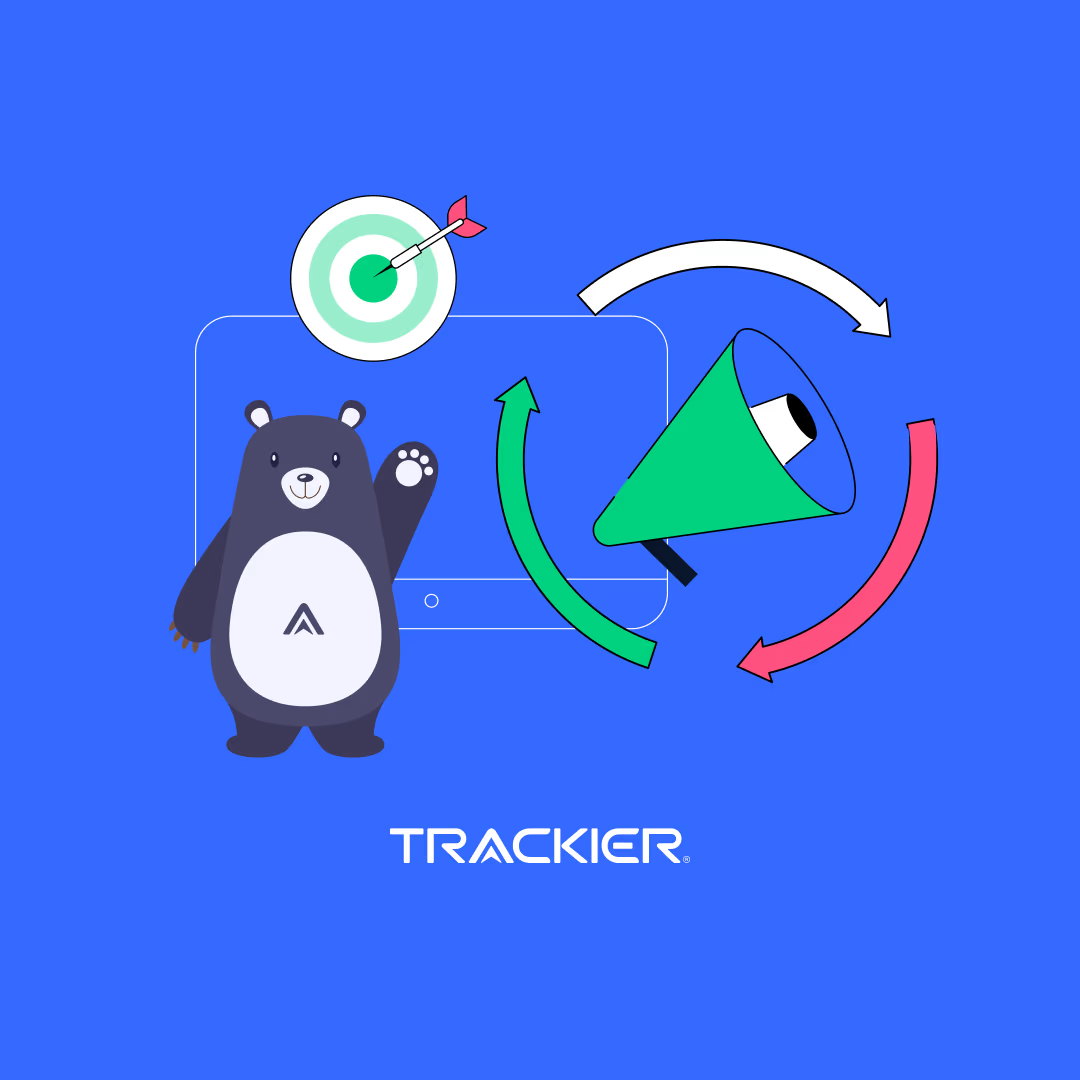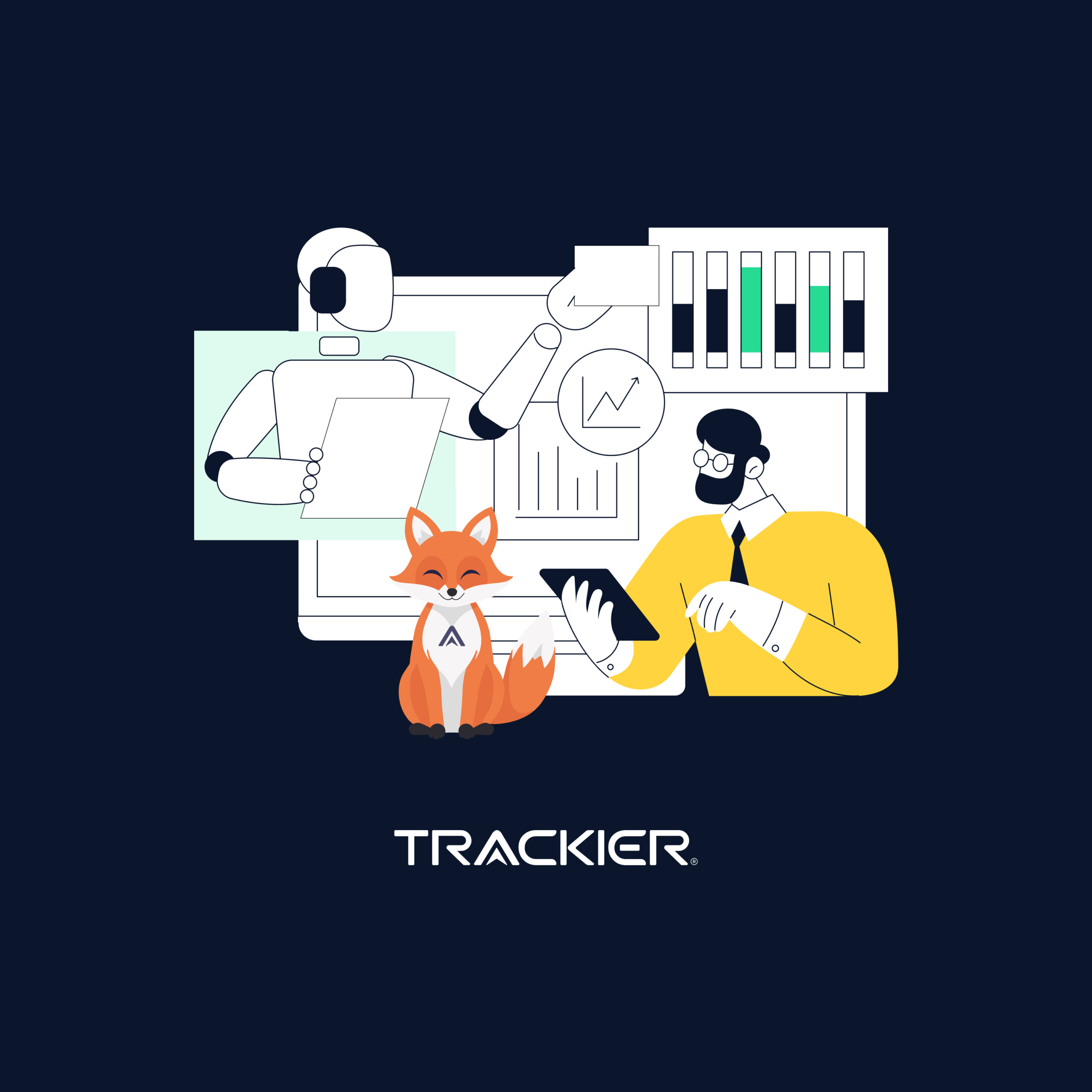Is your affiliate program stuck on a platform that offers inaccurate conversions, frustrating dashboards, and late payments? You are not alone.
Affiliate marketing spending is projected to grow to $40 billion by 2030, increasing from around $17 billion today. That growth is driven by performance- but only if tracking is accurate and payment is consistent.
This is where Trackier comes in. Working with brands in more than 20 countries, Trackier provides real-time reporting, first-party tracking, and SmartLink funnel optimization – all with industry-leading privacy protections for GDPR, CCPA, and many others.
This guide is not only about switching platforms. This is your peace-of-mind plan for the successful affiliate program migration:
- A pre-affiliate system migration readiness audit to confirm that switching platforms is the right decision for your team.
- A multi-tier risk, legal, and auditing process to help your affiliate program mitigate problems.
- A templated 8-week roadmap to go live successfully with zero downtime.
- Everything you need: communication scripts, KPI dashboards, audit sheets, and plans.
- Growth driver strategies to use after launch, like SmartLinks, segmentation, and retention loops.
Whether you are a D2C brand, SaaS organization, or performance agency, this guide gives you the ability to migrate and operate with clarity.
Should You Migrate? A Pre-Affiliate System Migration Readiness Audit
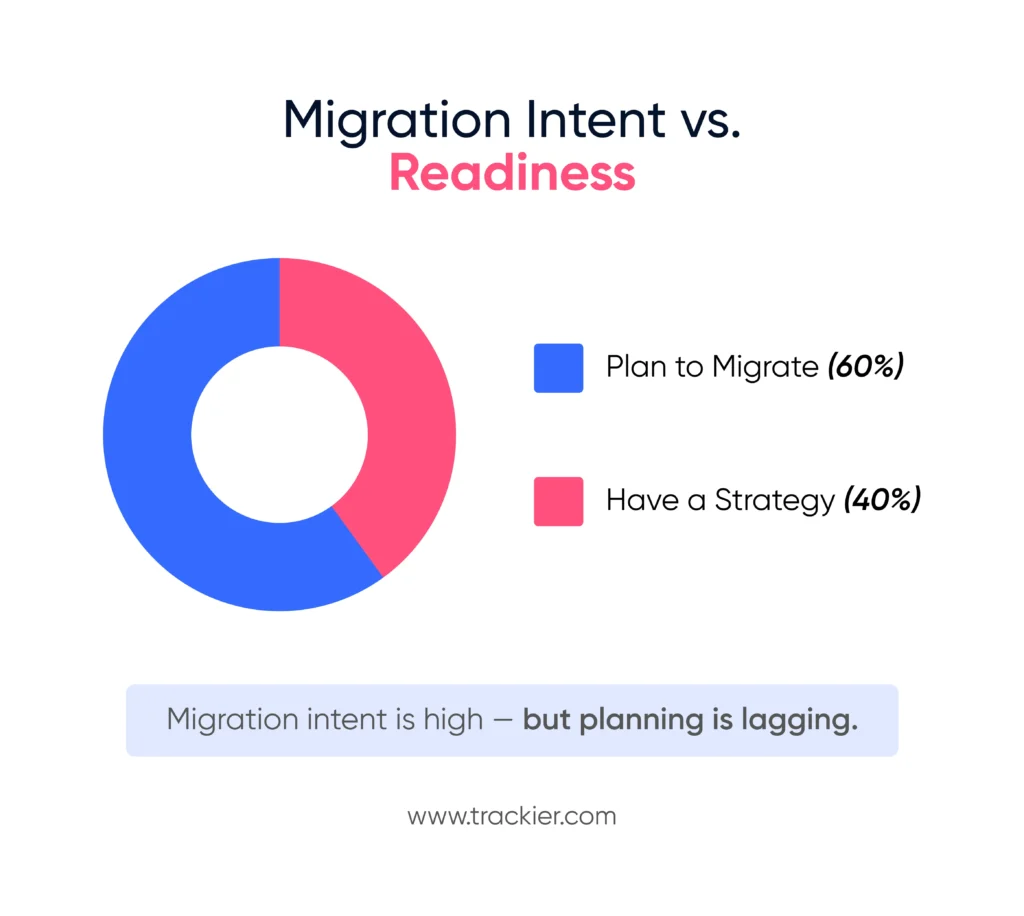
When done correctly, an affiliate system migration can improve your growth through a clean-up of inefficiencies that have often been buried for many years.
In fact, with 81% of brands and 84% of publishers using affiliate marketing today, ensuring you’re operating on the right platform has never been more critical.
But to do it too soon, or without a solid plan, may mean you are faced with data leakage, angry partners, missed conversions, or payouts.
Before you even consider migrating, you need to pause and ask yourself the most important question: Do we really need to migrate, or can we just make improvements to our existing platform?
Why is this Audit Necessary?
Very few brands migrate platforms for positive reasons. You have likely heard reasons that include:
- “Our reports are terrible.”
- “The fees are insane.”
- “We have outgrown our free plugin.”
All good reasons. But the reality is that there are trade-offs with every platform. Conducting a pre-affiliate system migration audit can help you to:
- Identify what is truly a pain point vs. what is just a nuisance. Also, evaluate if your current commission models are outdated or not.
- Avoid bringing the same problems over to a new platform.
- Unite the entire organization, like legal, partnerships, tech, and finance, on the same page before the affiliate program migration.
Step 1: Spot Early Red Flags
Begin with qualitative input, engage with people.
| Role | Most Common Complaints | Why is it Important? |
| Affiliate Partners | Tracking bugs, slow payments | Could lose trust or partners |
| Operations/Finance | Manual billing, unclear fees | High cost in time and money |
| Marketing/Analytics | Incorrect attribution, confusing reports | It is harder to optimize campaigns |
| Legal/Privacy | Complicated T&Cs, issues around GDPR/CCPA | Significant compliance risks |
Step 2: Assess the Costs vs. Benefits
Before abandoning the change, ask: Can we fix the mistakes instead? If you do fix what you already have, it is entirely possible that better onboarding, streamlined postbacks, or better fraud protection will achieve satisfactory results. You may even avoid the hassle of migrating altogether.
However, if you feel that a move makes sense, just make sure to frame the potential benefits:
- Better data
- Happier partners, more loyal partners
- Fewer payout disputes
- Faster optimization cycles
Step 3: It is essential to coordinate all teams.
Affiliate system migration is not simply an IT project. This activity impacts all teams, and without getting everyone on the same page, you will quickly start to create chaos:
You need to;
- Speak to your legal, tech, finance, marketing, and partnership teams.
- Identify everything they rely on, such as legacy reports, contract clauses, tiered payouts, etc.
- Get clarity on timelines to go-live, events that could be considered risks (like major partner churning), and fallback plans.
Step 4: Assemble Your Pre-Affiliate System Migration Toolkit
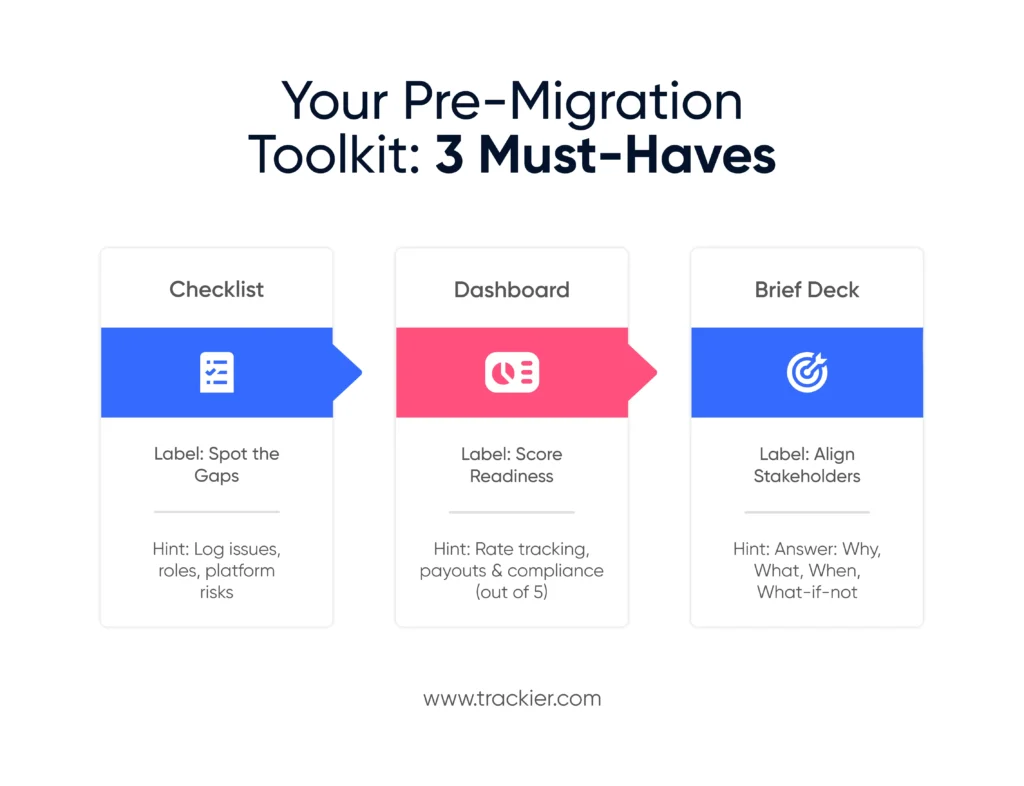
You have now completed your pre-affiliate system migration planning and preparation. Now it is time to focus on putting everything into a decisive and ready-to-use format:
- Pre-affiliate system migration audit checklist – to document all possible issues, impacted roles, and existing platform gaps.
- Readiness dashboard template – to score your success factors (tracking accuracy, compliance, payout flexibility), each out of five.
- Stakeholder brief deck – a four-slide overview that responds to these questions: Why migrate? What is changing? When? And what will be our outcome if we don’t?
Why Brands Migrate to New Affiliate Platforms?
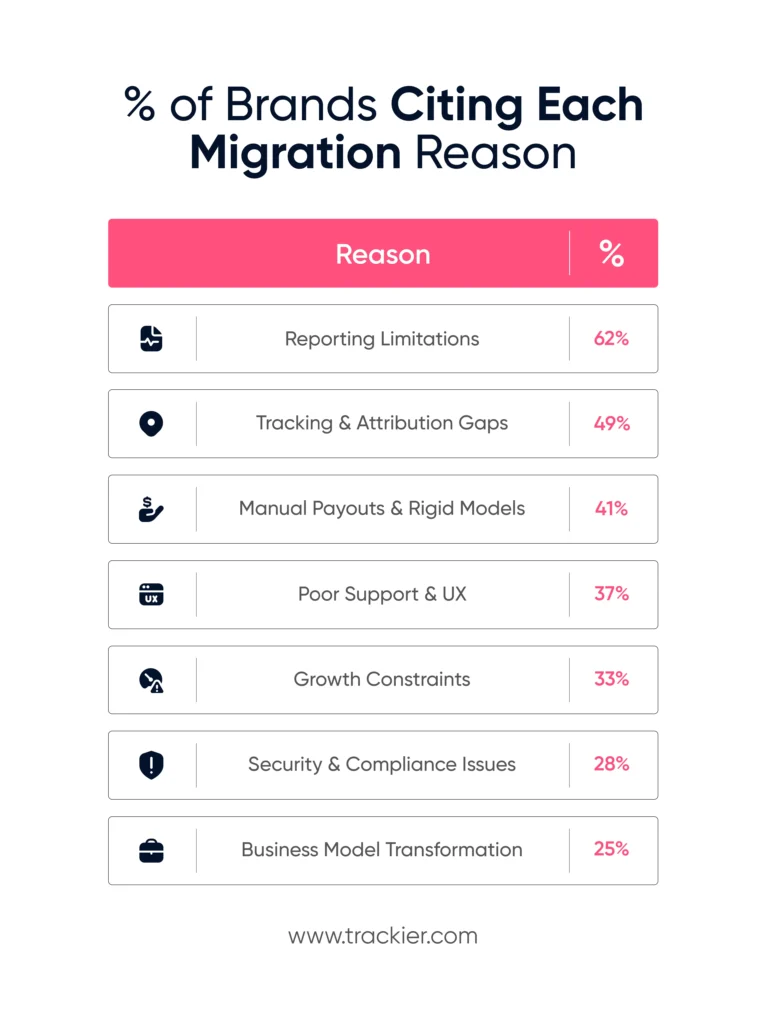
Brands generally do not switch affiliate platforms for fun; brands usually switch based on systemic limitations, growth needs, or growing frustration about not being script, and this ultimately impacts ROI.
Considering that major brands derive between 5%–25% of their online revenue from affiliate marketing and that retailers report affiliate programs boosting annual revenue by up to 20%, these limitations can significantly hinder business growth.
Understanding these pain points helps you position affiliate program migration not as a technical must, but as a strategic move towards manageable growth.
1. Lack of Reporting Transparency and Insight
The number one reason affiliate system migration is said to happen is reporting limitations and a lack of data visibility:
- Legacy, or network-based, platforms often only provide a rigid dashboard with noisy data; you can not access comprehensive insights.
- Without cross-channel tracking, multi-touch attribution, or conversion level, marketers can not optimize campaigns or protect ROI.
2. Constraints on Growth and Scalability
Most platforms become more challenging as the affiliate program scales:
- Inflexible pricing models (transaction or click-based) can increase growth costs.
- Lack of customization around commissions, tiered incentives, and link capacity constraints the growth of partners.
- Several brands simply outgrow the tools offered by affiliate networks and need a SaaS platform built for more volume and flexibility.
3. Poor Tracking, Broken Links, and Attribution Gaps
Tracking issues such as a mismatch between click and conversion data or incorrectly set up custom parameters, create commission disputes and destroy partner trust.
Broken tracking links, uncertain redirects, or inconsistent attribution models cause partners to lose attribution and ultimately lose trust in the platform altogether.
4. Manual Payment Processing & Rigid Commission Models

When brands only have manual payment processing, obsolete commission models, or specific payment schedules:
- Affiliates complain about payment delays, errors, or their inability to support new geographies.
- There is confusion around CPS vs. CPA vs. revenue-sharing commission models, and strict payment scheduling (net-30/60 versus instant payments) promotes distrust.
5. Poor Platform Support and Obsolete User Experience
User experience and customer support typically set growth platforms apart from legacy platforms:
- Brands report poor user experiences with outdated dashboards, weird navigation, and terrible support responsiveness.
- With poor user interfaces and no ability to access responsible and live help, affiliates and internal teams are left to manage delays and operational inefficiencies that come from the onboarding process.
6. Security and Compliance Restrictions
Once brands expand, regulatory obligations like GDPR, CCPA, and DPDP (in India) become very important. Legacy platforms may not have built-in consent management flows, encryption, or data portability.
Transitioning allows a brand to deploy privacy-by-design tracking, T&Cs versioning, and integrated workflows for compliance, if required.
7. Strategic Business Transformations and Ownership Models
Some brands move from an affiliate network to their own standalone SaaS solutions, or in-house managed programs:
- This change eliminates network commissions, sends all the data back to the brand, and allows for custom features if needed.
- Brands managed by growth teams or OPMs (Outsourced Program Managers) allow more latitude to recruit direct partners without the approval of the network.
Tired of tracking issues? Book your free demo!
Affiliate Program Migration Roadmap: An 8-week Plan to Migrate to Trackier Seamlessly
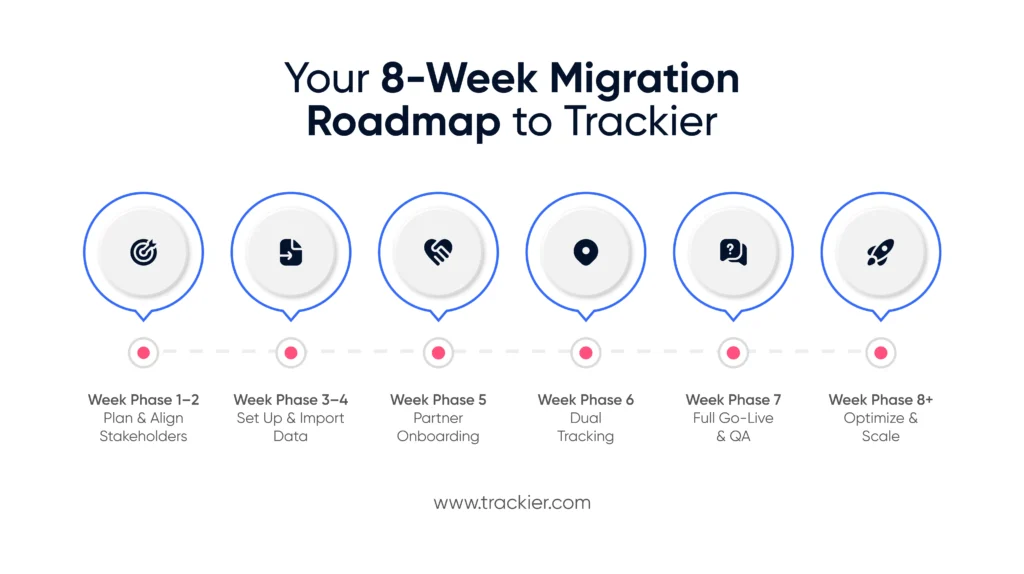
Migrating to a new affiliate platform can seem challenging, but it does not have to be. If you have an 8-week plan, you have a higher chance of reducing the chaos, and you can migrate smoothly. Here are the simple steps to do it:
Weeks 1-2: Align and Prepare All Stakeholders
This is your preparation phase. You have to make the planning and include the right people from the start. You will be focusing on:
- Ensure the affiliate program migration is really necessary.
- Include everyone, such as legal, tech, finance, and partnerships, and get alignment from every stakeholder in your affiliate program migration process.
- Commit to a timeline, outcomes, and a backup plan, if something goes wrong.
To-dos:
- Communicate audit results and set clear affiliate program migration objectives with each department.
- Create a tracker with milestones, owners, and escalation points.
- Log any risks that may arise in the affiliate program migration phase.
- Create a partner communication way: this includes email templates and a communication outreach schedule.
What you will have after this is done:
- A slide deck to align internal stakeholders.
- An affiliate program migration tracker (could be a Google sheet or a Trello board).
- You will have communication templates and a partner rollout plan.
Weeks 3-4: Start Setting Up Trackier + Import Your Data
This is the time for technical setup. You are now preparing Trackier, getting your data set up, and testing out how it all works together.
Key objectives for these two weeks:
- Set up a staging version of Trackier.
- Figure out how your existing data will match with Trackier’s system.
- Begin testing out some of your historical data.
What you will do:
- Configure your Trackier to set up postbacks, APIs, webhooks, etc.
- Import data like historical clicks, conversions, partner info, etc.
- Perform tests to see if your data is properly mapped.
- If you are connecting tools such as Shopify, CRMs, or ad platforms – ideally, connect early.
What you will deliver:
- A data mapping template showing how fields relate.
- A UI alignment report between what you expected and what you see.
- A straightforward technical architecture with integrations.
Week 5: Onboard Your Partners + Soft Launch
This is where you are going to start involving your partners. Provide an opportunity for them to test your platform to see what their experience is like and collect feedback, and make sure they are in a position to transition.
Goals:
- Get your super affiliates testing things out in the starting phase.
- Start rolling out onboarding and support.
Things for you to complete:
- Provide early access to important partners and guide them through the new platform.
- Schedule training calls to address questions and collect feedback.
- Run link replacement events to ensure old tracking links are replaced.
- Follow up with affiliates via email.
By the end of this week, you will have
- Visual onboarding flowchart.
- An affiliate program migration tracker showing contact status and link update progress.
- Partner feedback log and issue tracker.
Week 6: Dual Tracking + Controlled Cutover
You are going to start sending traffic to Trackier, but in a controlled way, to see if there are any issues that you find earlier in the process and to validate performance.
What you are doing:
- You are going to slowly send more and more traffic over to Trackier.
- Compare the metrics (clicks, conversions, payouts) with your previous platform.
- Adjust/Correct any attribution or reporting mismatches.
Next steps:
- Start with 25% traffic to Trackier and check the metrics.
- Change your setup if there are discrepancies greater than 0.5%.
- Steadily increase traffic by 25% at a time based on successful tests.
- Monitor dashboards side by side, track postbacks, conversions, and payouts.
End of the week deliverables:
- A performance tracker comparing both platforms.
- Logs of the tests done and discrepancies found.
- An update rollout calendar for the 100% cutover.
Week 7: Full Go-Live + Final QA Checks
You have tested, tweaked, and trained – now it is time to flip. This week is all about switching over completely and carrying out one final round of checks.
Objectives:
- Flip 100% of your traffic to Trackier.
- Essentially, everything is working – links, dashboards, payouts.
Tasks:
- Turn on your live campaigns.
- Work through your final QA checklist – tracking links, pixels, partner access, and reporting.
- Turn on the fraud prevention feature and check.
- Real-time marketing analytics are firing correctly.
- Let the finance and operations teams know on which days the payout will run (and check to see if you can test a few transactions in advance).
At the end of the week, you will have:
- A detailed QA checklist.
- Live dashboards providing proof of campaign parity.
- An issue log (in case anything pops up on Day 1).
After Week 8: Optimize, Scale & Strengthen Relationships
Congratulations, your affiliate program migration is finished. But your job is not done. Now begins the process of optimizing what works, fixing what does not, and starting to scale partner success.
Goals:
- Continue to measure performance and fix any gaps.
- Strengthen relationships with partners.
- Think about trying to enhance future initiatives to help you scale.
Things to work on:
- Keep an eye on your key KPIs (clicks, conversion rates, payouts, retention, AOV, LTV).
- Segment your affiliates and implement a tier-based incentive or re-engagement campaign.
- Utilize SmartLinks and tags for more thorough tracking across your performance marketing channels.
- Send out “live” post-launch emails with tips, updates, and support information.
- Check in with partners that have not fully onboarded you and offer assistance.
Final deliverables:
- Your KPI dashboard will follow the affiliate system migration.
- A report on your affiliate segmentations and re-engagement strategies.
- A partner update/communication email template.
Data Migration & Technical Integration
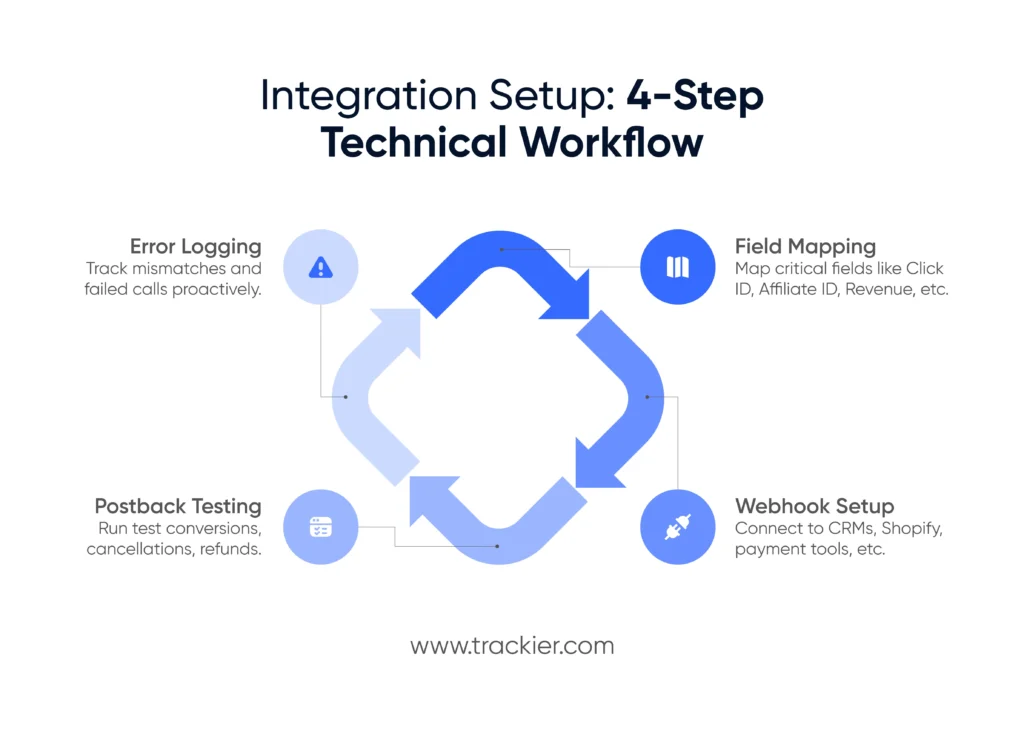
Migrating your data to Trackier is not easy. It requires comprehensive technical planning. You want to ensure tracking remains accurate, affiliate payouts will be timely, and campaigns remain intact once the new platform is live.
In this section, we will walk through some important considerations to help ensure a successful process: API mapping and webhooks, migrating historical data, and validating the integration with testing. We will break it down for you.
API Mapping, Postbacks & Webhooks
Trackier connects different platforms using APIs. It helps to handle everything from tracking clicks and conversions to handling affiliate payout and syncing data from partners.
However, a small mistake, like a misconfigured webhook or forgetting to add a parameter, can lead to big mistakes, like paying commission incorrectly or broken tracking.
Here is how to keep things simple:
- Start with Data Field Mapping – Identify the must-have fields like click ID, affiliate ID, revenue, and source of referral. Then, map each field from your existing tools to Trackier’s fields. This way, everything will be in alignment from the start.
- Set Up and Test Webhooks – Once you have mapped your data fields to Trackier’s standards, connect Trackier’s webhooks to tools you already use, including your payment processor, CRM, or Shopify store.
- Confirm Postbacks – Run some test events; for example, you could run a test conversion, a cancelled order, or a refund, and make sure that the data that Trackier is receiving is accurate.
- Document Errors – Make sure to log any errors for any failed calls or data mismatches. This way, if something gets off, your team will detect that earlier rather than later to ensure you don’t affect your real reports.
Best Practices for Migrating Historical Data
It is not a secret that historical data like click logs, conversion logs, and partner files is valuable for optimizing your campaigns and establishing trust with your affiliates. Collecting that information into a new platform required extra effort. Here is how to do it effectively:
- Start by Cleaning Your Data – Before you do anything, you need to take a survey of the information you have. You might find duplicates, out-of-date records, or poor data. Doing a quick audit and cleanup before moving your information can save time and cost.
- Prioritize Your Data – Not all data is created equal. Your most impactful records should be moved first. This includes your best affiliates, the last six months of conversions, and recent payout history. Older information can be archived for reference.
- Chunk Your Imports – Rather than importing everything at once, do it in chunks. This allows you a better opportunity to detect errors and remain organized.
- Backup Everything – Make sure to maintain a clean backup of all of your original exports in a secure, offline location. If anything goes wrong, you can bring it back.
Tracking Accuracy and Testing
Testing is important, as you can detect any issues before your partners do. By using your dummy campaigns, you can test everything from clicks to conversions without touching your live tracking.
Here is how to take advantage of it:
- Internal QA – Begin testing in small ways with limited data. Create mock campaigns, firing postbacks for test conversions or refunds to verify attribution, commissions, and custom parameters are working correctly.
- Partner Soft Launch – Invite a few of your top partners for a soft launch. Allow the partner to use the Trackier dashboard, play with their report objects, and observe the affiliate payout visibility previews with the integrations. Afterward, you can compare their outputs with your previous platform to ensure that you are both observing the same data.
- Dual Tracking Phase – Afterward, you can begin tracking in both systems. Route a small percentage of the traffic to Trackier may be 25% and keep the rest on your old platform. This is your time to compare outputs and assess whether or not tracking is working correctly between the two systems.
Expected Outputs and Visuals to Include
To support your affiliate program migration, here are some visual assets to keep on hand:
- API Mapping Table – Map out how any field from the previous platform maps into Trackier, including any logic or transformation applied.
- Data Import Tracker – keep track of your import batches, like tracking record count, errors, and statuses.
- Testing Dashboard – Log your soft launch testing results and document the parity of results with the previous system.
- Flow Diagram – Map out the entire path from the user’s click → conversion → postback → payout.
Partner Onboarding and Communication Strategy
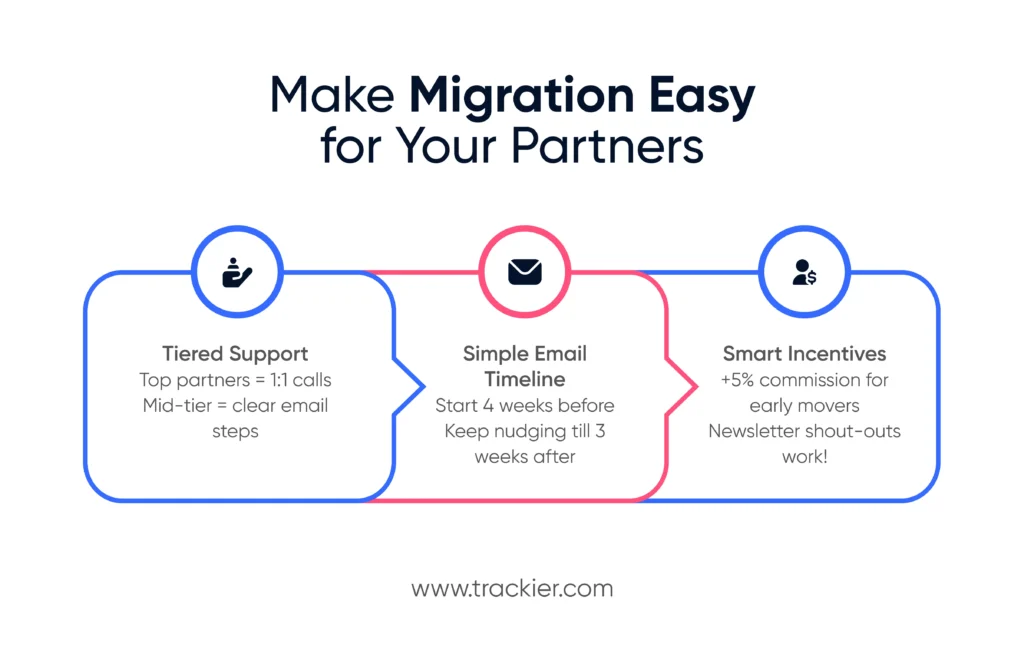
Switching affiliate platforms? Let’s make sure your partners do not feel any challenges. When you migrate platforms, it is not just about changing software; it affects how your partners work every day.
From updating links to learning a new dashboard, the transition can be overwhelming without the right support. That is why onboarding and communication are not just “nice to have”; they are non-negotiable.
Let’s walk through a step-by-step plan to help your partners stay in the loop, feel supported, and start promoting again.
Why Thoughtful Onboarding Matters?
Changing platforms can be disruptive, especially for your top-performing affiliates. A single broken link or confusing update can lead to lost revenue, or worse, lost trust.
But here is the good news: if you approach it right, you can bring more than 80–90% of your top-tier partners without any challenges. The key? Personalization, clear instructions, and timely follow-ups, especially for top partners who might need a bit more guidance.
A Tiered Communication Plan That Works
Let’s break it down by partner types:
- Tier 1: Top Revenue Drivers – These partners deserve a personal touch, think about one-on-one calls, customized walkthroughs, and priority support.
- Tier 2: Mid-Tier Partners – Send them segmented emails with clear instructions, timelines, and maybe even a small incentive will work.
Your Go-To Email Sequence
Here is a simple timeline to keep your partners informed:
- 4 Weeks Before – Alert Email: “We are moving platforms soon, here is what to expect.”
- 2 Weeks Before – Reminder Email: “It is coming up, start preparations.”
- 1 Week Before – Final reminder + invite to test the new system.
- Launch Day – Clear step-by-step instructions: “Grab your new links, log into your dashboard, let’s go.”
- 1 Week After – “Have not made the switch yet? Let’s fix that.”
- 3 Weeks After – Final Follow-Up: “Still stuck? We are here to help.”
Communication Toolkit: What to Send?
Email templates:
“Hey [Name], our new dashboard is live. Here is your invite.”
“Your new affiliate links are ready. Don’t forget to switch them.”
“Need help getting started? Join our onboarding call.”
“Still need to migrate? Let’s upgrade together.”
FAQs to include:
- Why are we switching platforms?
- What do you need to do?
- When does it go live?
- Where can you get help or resources?
Get Them Excited: Incentives That Work
A little motivation goes a long way. Here are some ideas to drive early link swaps:
- Boost commission rates by 5% for early movers.
- Shout out to the first 10 partners who switch in your newsletter.
- Give leaderboard recognition for fastest migrations.
As per the report, incentives like these can increase the chances of activation rates by 30% or more during affiliate program migration.
Affiliate Payouts: Easy Set Up and Models
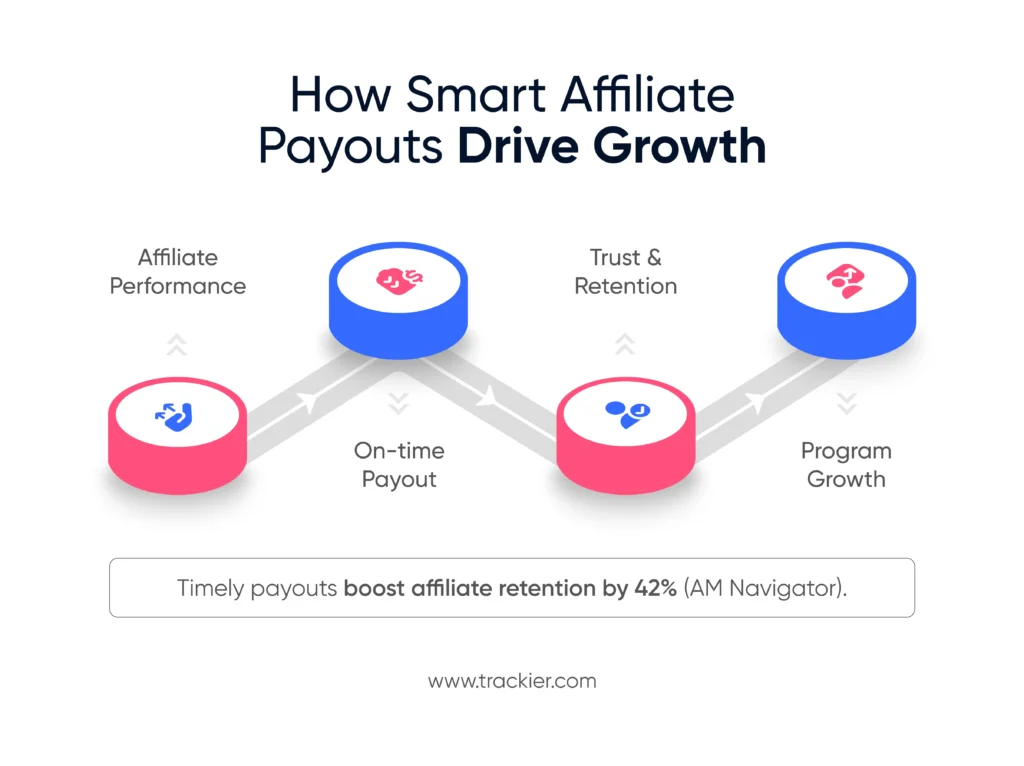
When establishing payouts for your affiliates, it is more than just an amount; it is about building trust, keeping your partners happy, and ensuring your accounting flows seamlessly.
In fact, more than 50% of affiliates say they will definitely scale their campaigns if payments were much faster.
So, let’s go through the more common payout models, how often to pay affiliates, dealing with global currencies, and tax compliance, with a focus on how Trackier makes the process easy to manage.
1. Commission Models Affiliates Want
Most affiliate programs use variations of a few established models, which you can see below:
- CPS models (Cost Per Sale) – You pay affiliates a flat fee or a percentage when a user makes a purchase. This model is ideal for e-commerce or selling digital products.
- CPA/ CPL models (Cost Per Action/Lead) – Your payouts are based on actions being taken, like filling out a form or creating a free trial account.
- Revenue share (RevShare) – Affiliates receive a percentage commission from every customer they have brought in for a pre-determined period. Typically, this model works well for subscription offers or any recurring revenue model.
- Hybrid models – This is a combination of paying upfront (CPS or CPA), plus continuing a revenue share. Best suited for high-ticket or multi-step funnels.
2. How Often Should You Pay Affiliates?
Giving predictable payouts builds trust. Here are the typical ways of payout structures in most programs:
- Monthly (Net-30) – A common way to pay affiliates and the industry standard. A month gives you enough time to handle refunds or chargebacks before payout.
- Bi-monthly or Weekly – Not very common, but could work great for a digital-only program or a program with a high number of transactions, trying to incentivize affiliates even further.
- Threshold-Based Payouts – Pay affiliates only when they reach a certain threshold you decide (e.g. $50 or ₹5,000). This will help limit your transaction costs.
3. Paying Affiliates Globally is possible.
Providing flexible payout methods and currency options will keep your global affiliates happy and more loyal.
- Bank Transfers (ACH, NEFT, SEPA) – Reliable with limited fees for local payouts to bank accounts.
- PayPal / Payoneer / Wise – Fast with internationally friendly payments, but keep track of fees.
- Cryptocurrency or E-wallets – One of the good secondary options to provide affiliates for global-first or tech-savvy audiences.
Trackier can assist you by providing:
- Auto currency conversion.
- Tex threshold and local withholding are automatically calculated.
- Region-based payout settings for the minimum payout and fee limit.
4. Tax Compliance
As your affiliate program scales, staying compliant with tax laws becomes essential. Here is what to remember:
- For U.S. affiliates – Collect W-9s (for residents) or W-8BENs (for non-residents). This will help you avoid automatic 30% withholding.
- For Indian affiliates – Get PAN along with GST and manage TDS.
- For everyone else – Be GDPR-compliant, especially when it comes to how you are storing and processing affiliates’ data.
If you have Trackier, you can:
- Automatically collect and store tax documents.
- Be notified when forms have expired.
- Create and download end-of-year summaries like 1099s in probably 5 clicks.
Start Scaling with Affiliate Tracking Software Today!
Launch Day & Operational Checkpoints
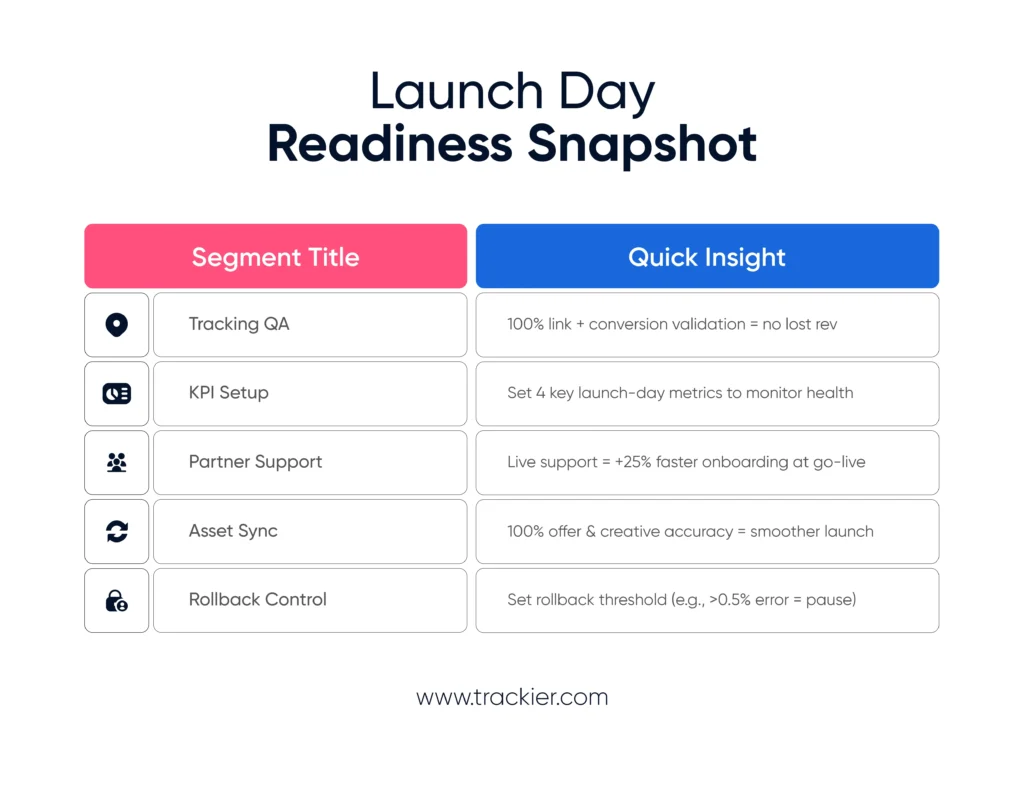
The launch of your affiliate program from your current system to Trackier involves strict verification, a forward-thinking issue log, and careful communication with your partners.
This section provides a checklist for things to remember to review to ensure you are ready to go on launch day and that your systems are in order.
1. Technical QA and Tracking Validation
Confirm the tracking accuracy from beginning to end:
- Validation of Conversions and Clicks – Go live with validation through a dummy test campaign. Create live test clicks and conversions to confirm postback communication, tracking, attribution, and commission book triggers firing in Trackier.
- Validation of Links – Ensure all affiliate links, redirects, smartlinks, deep links, whatever they may be, to ensure links work correctly and your conversions are accurately attributed to your affiliates. Broken links mean you are not getting revenue, and you can lose affiliate trust.
- Validation of Dashboards – Take time to compare data between old dashboards and key metrics in Trackier. We suggest that you identify important metrics such as click volume, conversion rates, and revenue data, and then compare them.
- Fraud/Rule Validation – Confirm fraud detection rules and postback validation rules are turned “ON” from day one to minimize suspicious or duplicate activity.
2. Goal Setting and KPI Monitoring Setup
Define launch metrics and daily checkpoint metrics for the ongoing health of the program:
- Set KPIs related to click volume, conversion rate, average order value, and payout accuracy before launch.
- Set your dashboards in Trackier to monitor in real-time, and compare throughout and errors to benchmarks.
3. Go Live Partner Operations and Support
Act like a partner-first brand at go-live:
- Partner support desk should be open.
- Ensure that help channels are fully resourced to address questions related to payouts, link access, onboarding support, etc.
4. Creative Asset and Offer Sync Checks
Verify that all creatives and offers have been properly transferred:
- Check the inventory of creatives – landing pages, banners, special links, and ensure affiliates have access.
- Ensure that the offer terms, caps, and start-end dates are totally transferred and operational.
5. Real-time Monitoring and Rollback Control
Check system logs for failed API/postback within hours of go-live. Also, check the conversion error against the threshold established prior (e.g.,>0.5 delta would cause rollback).
Growth, Boost, and Post-Launch Optimization
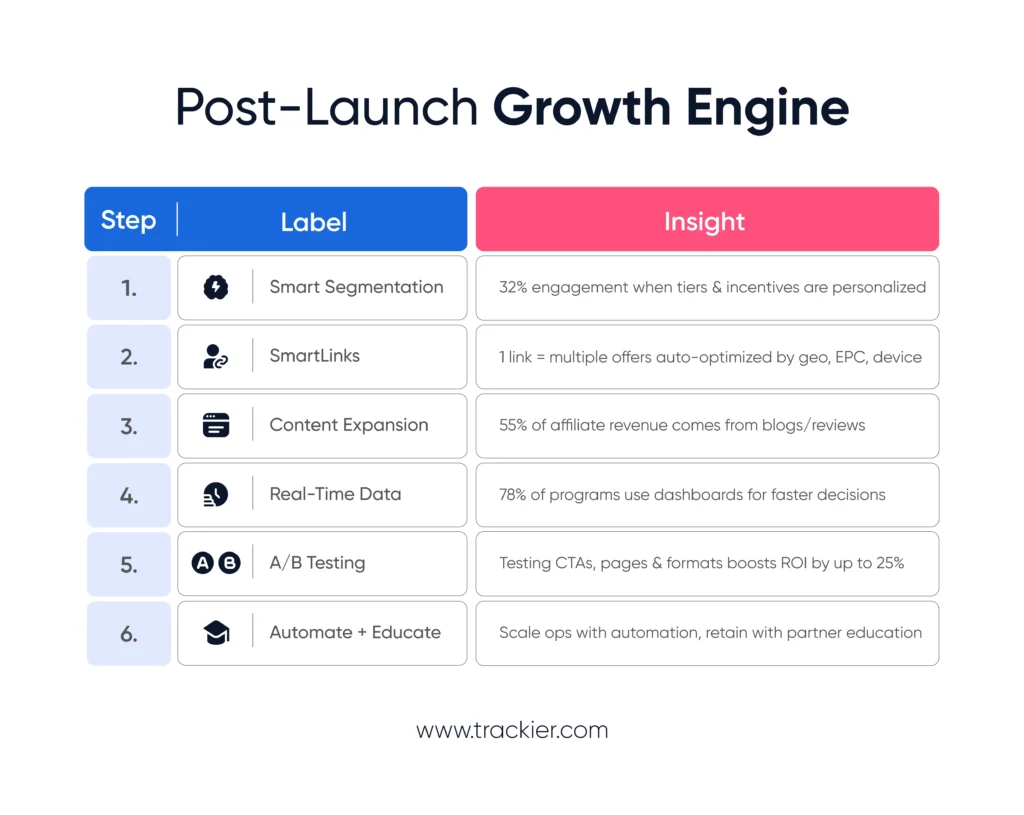
Once your affiliate program is launched on Trackier, the real work begins. It is about scaling better performance, scaling those relationships with your partner’s equity, and constantly optimizing for the long-term.
In this section, we will share how to initiate talent growth loops, unleash the features of SmartLink, and develop a data-backed optimization plan to keep the growth happening.
1. Start the Growth with Smart Segmentation, Incentives, and Tiers
If you want your affiliates to stay active and engaged, thoughtful incentives matter. So, start by segmenting based on performance like clicks, conversion rates, etc.
This will allow you to communicate with those who are segmented, which is way more compelling than a blank message.
You could reward your high-performers with exclusive bonuses, while the rest could benefit from development/support campaigns.
2. Use SmartLinks to Automatically Optimize Offers
SmartLinks are traffic smart routers for affiliates because they will take a user to the offer that is most likely to convert for them, based on location, devices, EPC, or conversion rate.
With SmartLinks on Trackier, you can:
- Utilize one link to monetize traffic across multiple offers.
- Conduct A/B split tests using links to split traffic to the different offers to see which performs best.
3. Explore With More Channels and Content
Once you have everything set up and organized, it is time to expand. Add email marketing to your strategy. Create segmented lists, build drip campaigns, and offer your audience exclusive deals.
Do not rely only on affiliate links. Affiliate content like blogs and reviews accounts for a majority of affiliate-driven revenue, about 55%, while video content delivers a 49% increase in conversions. By leveraging both formats, you can maximize reach and engagement.
Focus on more content like blogs, how-to-articles, comparison pages, or affiliate directories to increase clicks and conversions.
4. Use Real-Time Data to Improve Your Workflows
To optimize your campaigns, you need clear and instant visibility. In fact, 78% of affiliate programs use dashboards to quickly find what’s not working, shift budgets, and improve ROI.
With Trackier’s real-time dashboards, you can easily track performance, make quick changes, and double down on what’s working, before it’s too late.
5. Test, Test, Test – And Test Some More
Optimization is a process that you should repeat multiple times. So keep testing! A/B test everything from landing pages to CTAs, email subject lines, and even any social creatives you run.
Experiment with different affiliates’ assets too – banners vs text links, SmartLinks vs traditional links. Both trials and replicating what you see succeed will help to build a comprehensive affiliate program.
6. Automate Recurrent Work and Support your Partners.
Do not do it all manually; automate that tasks that need to be routinized, but make the interactions personal.
Automate onboarding emails, nurture sequences, and warning notifications that can alter affiliate behaviours.
Keep your partners informed about opportunities and ideas through webinars, quick training videos, or optimization tips.
Make smarter, data-backed decisions — Talk to our experts!
Final Thoughts
You’ve completed all the stages: verifying readiness, legal compliance, technical flagging, stakeholder correspondence, launching checklists, and optimization flows.
Here is what’s next:
- Get the affiliate program migration toolkit – Download the entire suite of audit checklists, partner email templates, affiliate system migration schedules, and KPI dashboards.
- Book a demo with Trackier – To see exactly how Trackier delivers on your affiliate strategy, onboarding workflows, SmartLink logic, and tax automation.
- Take your first step today – Use the pre-affiliate system migration audit to see if your legacy platform is a blocker, or even if smart execution can unlock the next phase.
- Done properly, affiliate system migration isn’t just a change of platforms – it’s a strategic move: accurate tracking, scalable payouts, and smarter affiliate growth. Let’s get you there.
Ready to get started? Get your personalized session with our experts!
